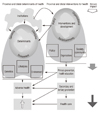Abstract
The healthy cities approach emphasizes the role of the leadership of local governments in promoting the health of the population in city settings. The concept emerged from public health strategies declared in the Ottawa Charter for Health Promotion, and reflects the characteristics of the third public health revolution. The Korean healthy cities movement, characterized by voluntary participation of local governments in the Alliance for Healthy Cities, has grown rapidly in recent years. A strong push of the healthy cities movement by a local government without a profound commitment to the vision may hinder the effective and sustainable development of the movement. By reviewing the historical background and significance of the healthy cities movement and its underlying concepts, and illustrating the main strategies and goals of the movement, that is, the development of partnerships, community participation and empowerment, and working in networks for stimulating change, this article argues that the healthy cities movement is a potent vehicle for implementing the new paradigm of public health introduced to local governments. We also argue that the Korean healthy cities movement needs more active participants and more support of the central government and other related stakeholders.
Figures and Tables
Figure 1
Healthy Cities meta-theory. Adapted from de Leeuw [19] with permission from Oxford University Press.

References
1. Baum FE. Healthy Cities and change: social movement or bureaucratic tool? Health Promot Int. 1993. 8:31–40.

2. de Leeuw E, Skovgaard T. Utility-driven evidence for healthy cities: problems with evidence generation and application. Soc Sci Med. 2005. 61:1331–1341.

3. Kim JH. Review for open discussions about health cities program. Health Soc Sci. 2007. 21:137–156.
4. Kim Y. Healthy cities, healthy communities. J Korean Plann Assoc. 2007. 42(1):5–6.
5. Nam EW. Review and prospective of the healthy cities in Korea. J Korean Soc Health Educ Promot. 2007. 24(2):123–134.
6. Nam EW, Shin T, Song YL, Park JS, Park KS, Song TM, Kim MK. Building web database for WHO healthy city Wonju. J Korean Soc Health Educ Promot. 2007. 24(3):119–128.
7. Kim JM, Koh KW. Assessment of individual, organizational, envirommental capacity for healthy cities. J Korean Soc Health Educ Promot. 2009. 26(2):119–133.
8. Jung GH, Kim KY, Na BJ. The characteristics of healthy city project in Korea. J Agric Med Community Health. 2009. 34:155–167.

9. Omran AR. The epidemiologic transition: a theory of the epidemiology of population change. 1971. Milbank Q. 2005. 83:731–757.

10. Olshansky SJ, Ault AB. The fourth stage of the epidemiologic transition: the age of delayed degenerative diseases. Milbank Q. 1986. 64:355–391.

11. Brown TM, Cueto M, Fee E. The World Health Organization and the transition from "international" to "global" public health. Am J Public Health. 2006. 96:62–72.

13. Potvin L, McQueen D. McQueen DV, Kickbusch I, Potvin L, Pelikan JM, Balbo J, Abel T, editors. Modernity, public health, and health promotion: a reflexive discourse. Health and modernity: the role of theory in health promotion. 2007. New York: Springer;12–20.
14. Dempsey C, Battel-Kirk B, Barry MM. The CompHP core competencies framework for health promotion handbook. 2011. Galway: Executive Agency for Health and Consumers (EAHC), National University of Ireland Galway.
15. Kickbusch I. The contribution of the World Health Organization to a new public health and health promotion. Am J Public Health. 2003. 93:383–388.

16. Hancock T, Duhl L. WHO Healthy Cities Papers, No. 1. Promoting health in an urban context. 1988. Copenhagen: WHO Regional Office for Europe.
17. Lawrence RJ. Galea S, Vlahov D, editors. Building healthy cities: the World Health Organization perspective. Handbook of urban health: population, methods and practice. 2005. New York: Springer;479–502.
18. de Leeuw E. Evidence for Healthy Cities: reflections on practice, method and theory. Health Promot Int. 2009. 24:Suppl 1. i19–i36.

19. WHO Regional Office for Europe. Twenty steps for developing a Healthy Cities Project. 1997. 3rd ed. Copenhagen: WHO Regional Office for Europe.
20. Green G. Health and governance in European cities: a compendium of trends and responsibilities for public health in 46 member states of the WHO European Region. 1998. Copenhagen: WHO Regional Office for Europe.
21. Green G, Price C, Lipp A, Priestley R. Partnership structures in the WHO European Healthy Cities project. Health Promot Int. 2009. 24:Suppl 1. i37–i44.

22. WHO Regional Office for Europe. Community participation in local health and sustainable development: approaches and techniques. 2002. Copenhagen: Centre for Urban Health, WHO Regional Office for Europe.
23. Brager G, Specht H. Community organizing. 1973. New York: Columbia University.
24. Davidson S. Spinning the wheel of empowerment. Planning. 1998. 1262:14–15.
25. Heritage Z, Dooris M. Community participation and empowerment in Healthy Cities. Health Promot Int. 2009. 24:Suppl 1. i45–i55.

26. Capello R. The city network paradigm: measuring urban network externalities. Urban Stud. 2000. 37:1925–1945.

27. Tsouros A. City leadership for health and sustainable development: the World Health Organization European Healthy Cities Network. Health Promot Int. 2009. 24:Suppl 1. i4–i10.

28. Lafond J, Heritage Z, Tsouros A, Farrington J. National healthy cities networks: a powerful force for health and sustainable development in Europe. 2003. Copenhagen: WHO Regional Office for Europe.
29. Janss Lafond L, Heritage Z. National networks of Healthy Cities in Europe. Health Promot Int. 2009. 24:Suppl 1. i100–i107.

30. Eriksson C. Learning and knowledge-production for public health: a review of approaches to evidence-based public health. Scand J Public Health. 2000. 28:298–308.

31. Birckmayer JD, Weiss CH. Theory-based evaluation in practice. What do we learn? Eval Rev. 2000. 24:407–431.
32. O'Neill M, Simard P. Choosing indicators to evaluate Healthy Cities projects: a political task? Health Promot Int. 2006. 21:145–152.
33. Curtice L, Springett J, Kennedy A. Evaluation in urban settings: the challenge of Healthy Cities. WHO Reg Publ Eur Ser. 2001. (92):309–334.




 PDF
PDF ePub
ePub Citation
Citation Print
Print


 XML Download
XML Download